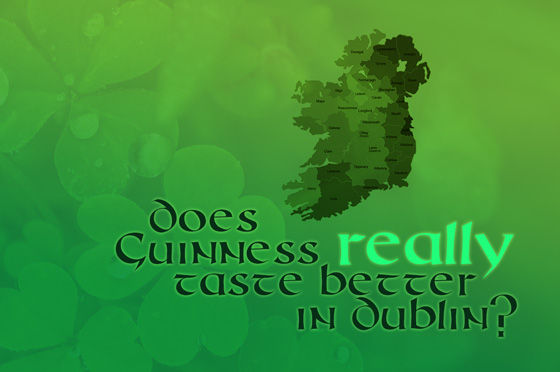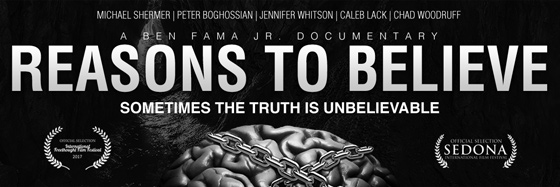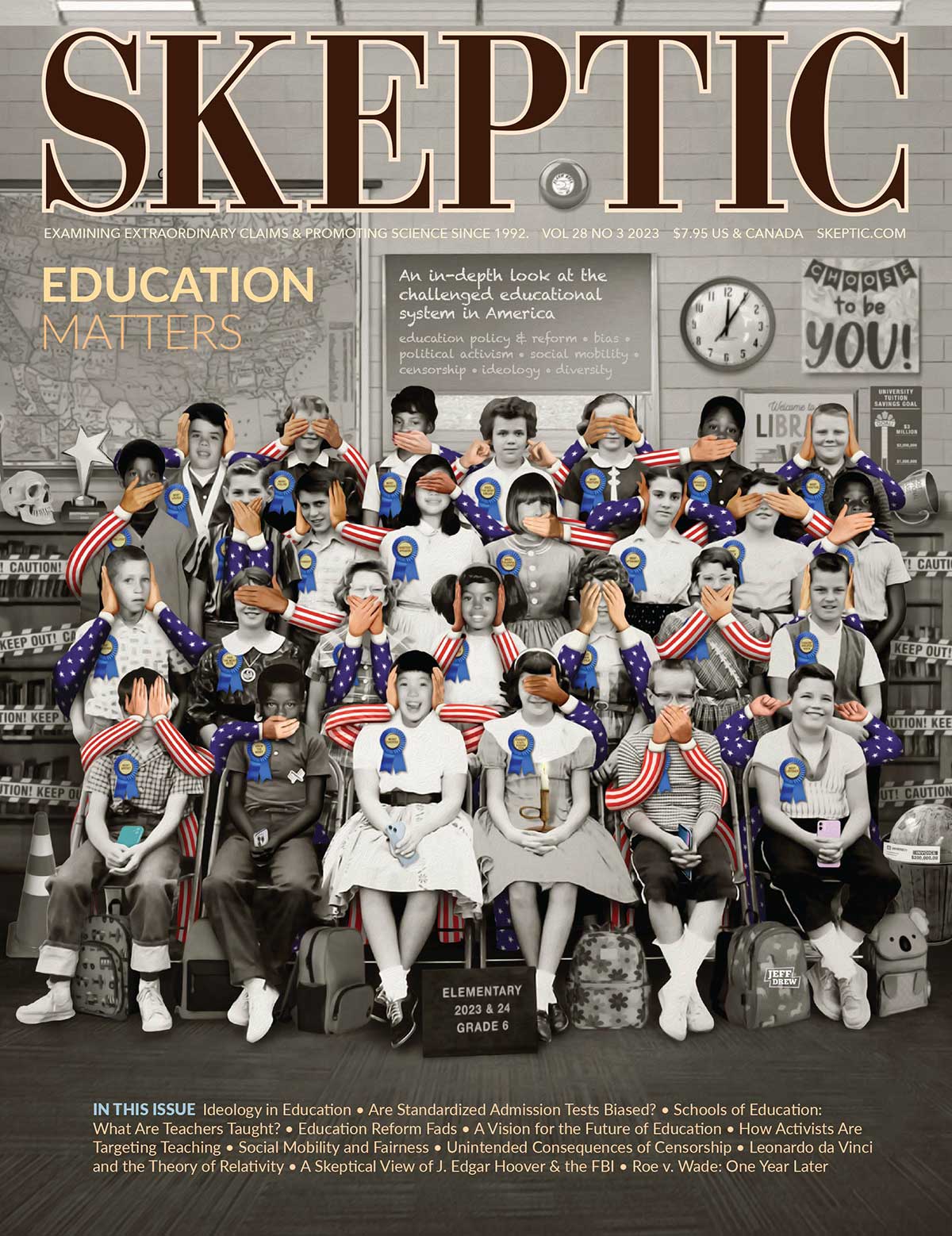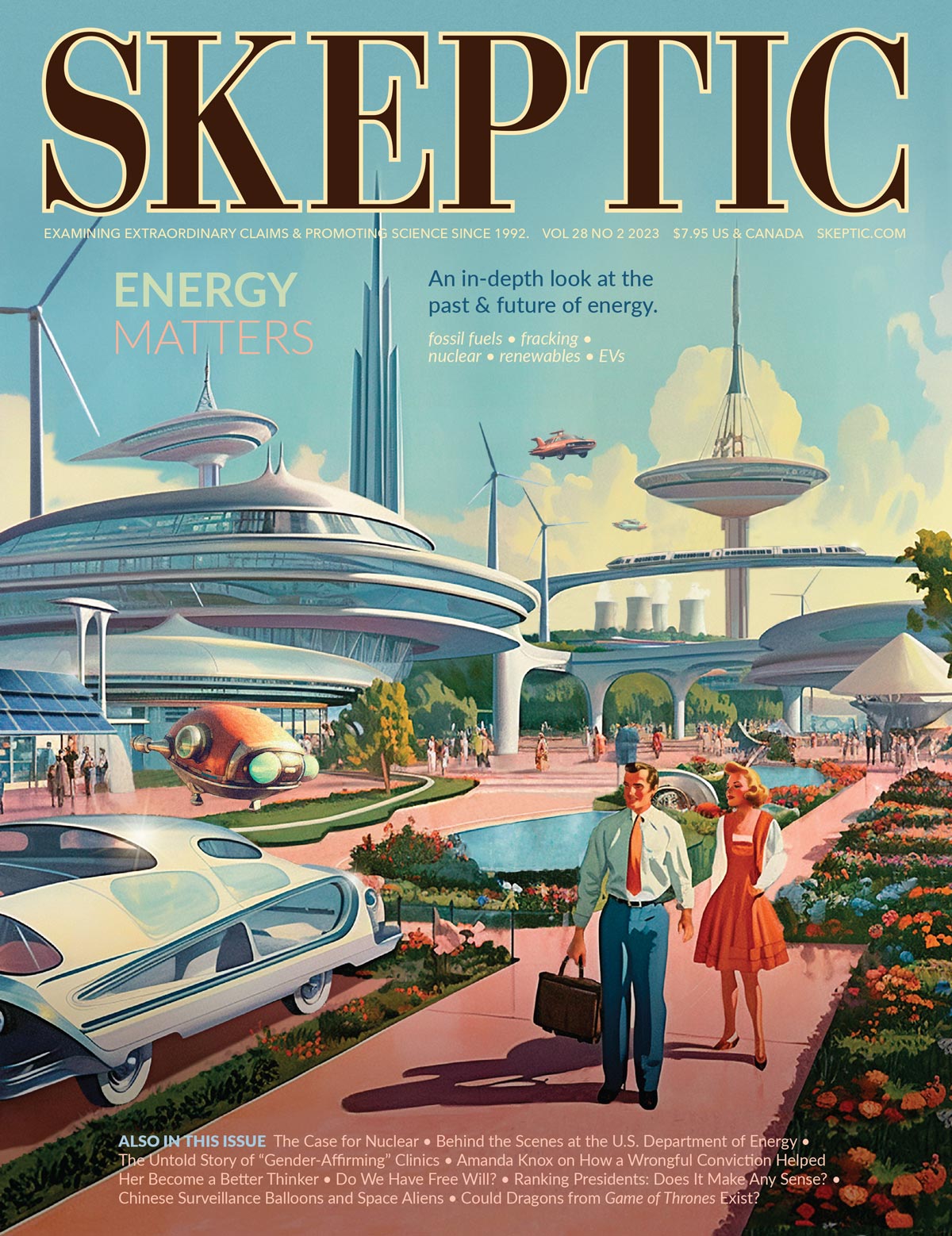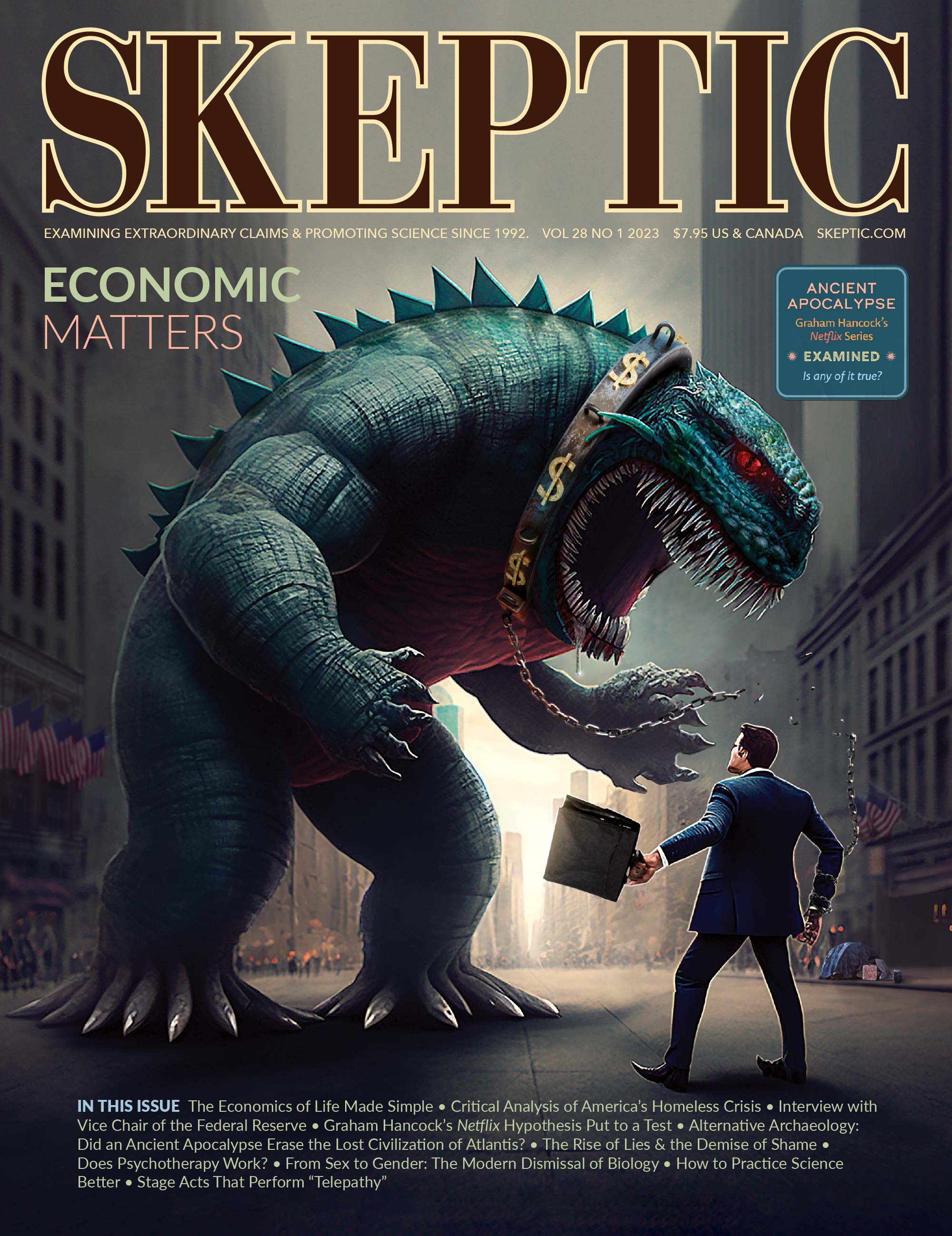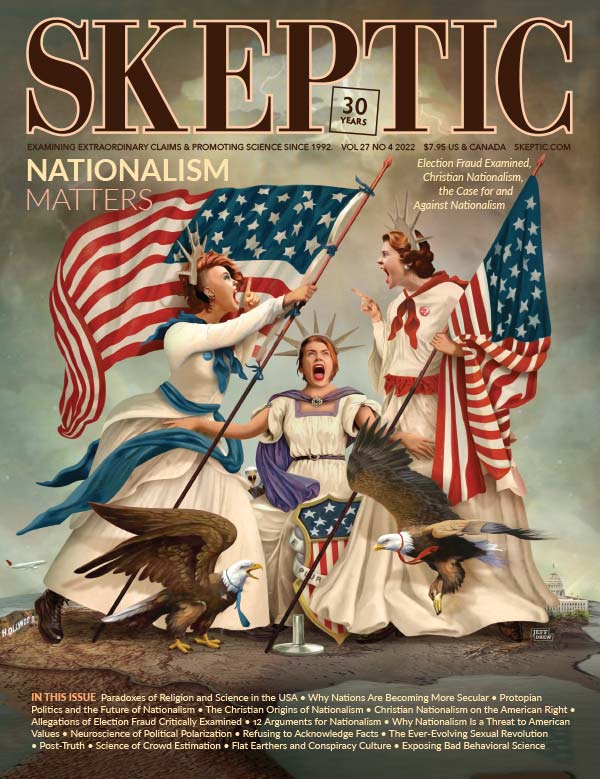In this week’s eSkeptic:
- Grand Irish Odyssey: 19-day Geology Tour of the Emerald Isle in 2018
- Science Salon Sept. 17: Dr. Nancy Segal — Twin Mythconceptions
- Promotional Offer: Save 25% off the Reasons to Believe film on Vimeo
- Debate Sept. 15: Is God a Figment of Our Imagination? Shermer v. McGrath
- Debate Oct. 19: Solving Moral Dilemmas: How Do We Know What’s Right?
2018 | IRELAND | JULY 15–AUGUST 2
Join us for a 19-day tour of the Emerald Isle
Ireland’s famed scenic landscape owes its breathtaking terrain to a dramatic 1.75 billion year history of continental collisions, volcanoes, and glacial assault. Join the Skeptics Society for a 19-day immersive tour of the deep history of the Emerald Isle, while experiencing the music, hospitality, and verdant beauty that make Ireland one of the world’s top travel destinations.

DAY 1
Sunday July 15: Dublin — A Geological City Arrival & Welcome Reception Day
Please Note: An optional tour will be available this day provided there are a sufficient number of members who check-in in time.
The rich geological heritage of Ireland is literally present in every street and building in Dublin. A geological walking tour of the city culminates with a behind the scenes visit to the Geological Museum at Trinity College, which is housed in the majestic, 19th century, Byzantine-inspired Museum Building, incorporating many of the rocks we’ll see over the coming days.
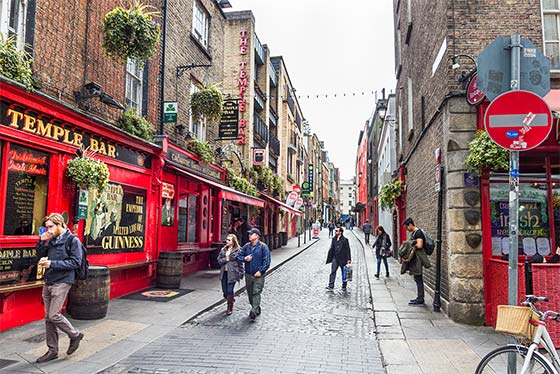
The Temple Bar district is promoted as Dublin’s cultural quarter and has a lively nightlife. Many Irish cultural institutions are located here including galleries and studios, and Centres for film, art and acting.
DAY 2
Monday, July 16: Beer & Gardens
Ahem. Drink up the history of Ireland’s renowned beverage at the Guinness Storehouse. An interactive tour of the facilities concludes with a frothy pint in the Gravity Bar: a seven-story, glass-walled facility, offering panoramic views of the city.
Explore the National Botanic Gardens. Over 20,000 plants, housed in 19th century iron and glass greenhouses. The Gardens played a crucial role in the identification of the pathogen behind the Irish Potato Famine and continue to be the site of important botanical research.
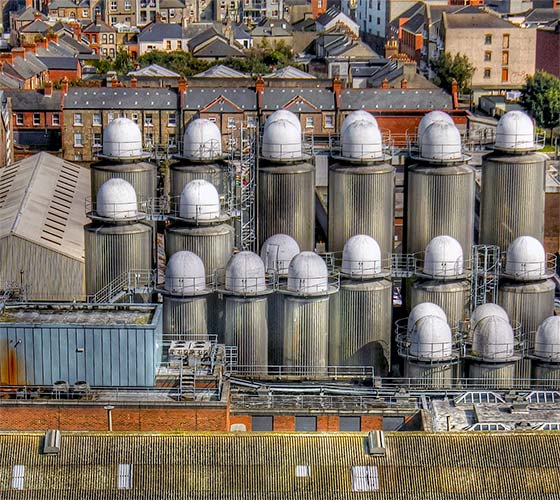
View from Gravity Bar at the top of Guinness Storehouse, Dublin, Ireland. Photo by psyberartist [CC BY 2.0], via Wikimedia Commons.
DAY 3
Tuesday, July 17: Mountains & Monasteries
The day begins in Wicklow Mountains National Park: rolling granite peaks wrenched upwards 420 million years ago as ancient Ireland collided with North America. Later smoothed by glaciers, the mountains host a unique heath and bog ecosystem, home to rare orchids and carnivorous plants.
Then it’s a visit to Glendalough monastic city. An ancient institute of higher learning, the 10th century complex of churches and monuments is situated in an idyllic glaciated valley (Glendalough means ‘Valley of the Two Lakes’).
For those with a little more energy, a gentle walk past the upper lake takes you to the Glendalough Miner’s Village, the ruins of 18th century silver and lead mine, where you can search for the rare mineral pyromorphite.
DAY 4
Wednesday, July 18: Ancient Organisms, Lighthouses & Crystal
Most of the enigmatic Ediacaran Biota died out before the Cambrian Explosion. A few species held out, however. At Booley Bay, you’ll get to touch the remains of Ediacaria, one of the final representatives of Life’s first animal experiment.
From there, it’s off to the Hook Head Lighthouse. Perched on fossil-rich Carboniferous limestones, the Hook Head Lighthouse has guided mariners for almost 800 years, making it the world’s second oldest operational lighthouse.
Then then take some free time in the afternoon to explore the charming city of Waterford. Home to the famous Waterford Crystal, this small port city is the oldest in the Ireland.
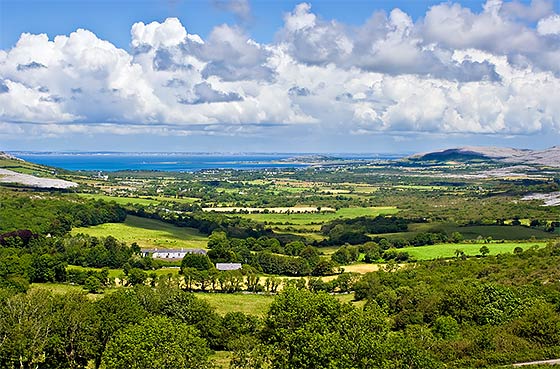
Landscape of County Clare, Ireland. Green fields in foreground and Galway Bay in the background. Beginings of the Burren can also be seen.
DAY 5
Thursday, July 19: Copper & Fire
Spend the day visiting the tops sites of the UNESCO Copper Coast Geopark, including rare columnar rhyolites, spectacular copper minerals, mine audits, pillow basalts, and hyaloclastites—mixtures of volcanic glass and lava formed during the explosive interaction of lavas and ocean water.
For a break from the geologic, we’ll take lunch in the picturesque village of Dungarven, followed by a chance to browse local artisans, visit the quaint and lovely Waterford County Museum, and explore Dungarven Castle.
DAY 6
Friday, July 20: Countryside Carved by Water
Cirques are nature’s amphitheatres. Steep-sided open valley’s gouged by glaciers, they often possess a central lake, called a tarn. We’ll begin the day at Coumshingaun Lough, widely considered one of the finest and most beautiful examples both features in Great Britain.
From there we head underground to witness the erosional power of streams on a guided tour of the Michelstown Cave, one of Europe’s most spectacular show caves. Massive limestone caverns filled with stalactites and other structures will take your breath away.
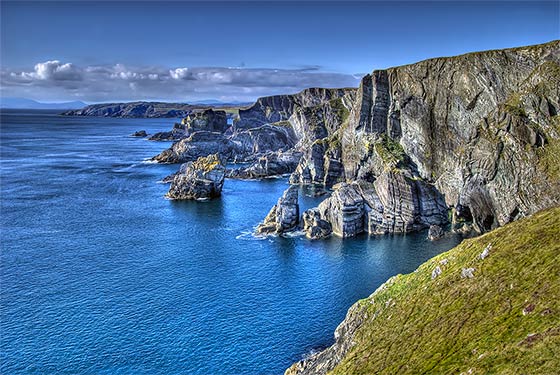
Mizen Head is located at the extremity of the Kilmore Peninsula and was one of the last points seen by those traveling to the Americas. The harsh beauty of the cliffs, primarily composed of deep seated Devonian slates, provides nesting sites for numerous seabirds, including Kittiwakes, Cormorants, and Gannets.
DAY 7
Saturday, July 21: Bridge to the South
Today we head south—as far south as you can go in Ireland—to visit Mizen Head, ranked as one of the 100 Great Geosites. Devonian metamorphic rocks create dramatic cliff vistas, accessible by the brave via a 180’ tall pedestrian bridge. A tour of the lighthouse, signal station, and visitor center to learn about the site’s importance in the history of transatlantic radio communication add a human dimension to the stop.
From there we head through the scenic Killarney National Park with a short stop in Killarney on our way to our next hotel where we rest up for the next exciting day ahead.
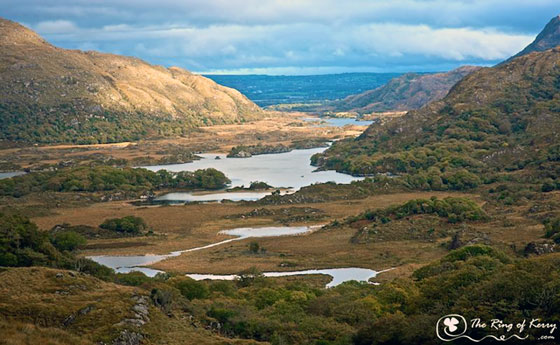
Ladies View — a scenic point along the Ring of Kerry. The name stems from the admiration of the view given by Queen Victoria’s ladies-in-waiting during their 1861 visit.
DAY 8
Sunday, July 22: The Force Awakens
The day begins with a tour of the iconic Ring of Kerry. One of the world’s most beautiful scenic drives, this 110 mile loop passes through picturesque villages, rugged coastline, and lush green countryside.
From there we’ll head to Valentia Island to see one of the oldest and longest tetrapod trackways on Earth. 50 feet long, these 380 million year old footprints represent some of the first steps ever taken on land by our deep ancestors.
Finally, we’ll take a boat 8 miles to the UNESCO World Heritage Site of Skellig Michael. You’ll recognize the islands as Luke Skywalker’s otherworldly refuge in the finale of Star Wars: The Force Awakens. Ecologists, geologists, and archaeologists have long recognized them as one of the most important seabird colonies in Ireland, a classic example of fault-mediated geomorphology, and the site of a 7th century monastery.
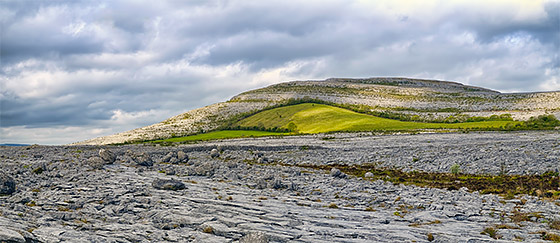
The Burren is a karst-landscape region in northwest County Clare, in Ireland. The limestone is up to 800 meters thick and formed as sediments in a tropical sea approximately 325 million years ago.
DAY 9
Monday, July 23: Volcanoes of Sand
Today is all about sediments and structures. A series of stops take us to textbook examples of weird and wild geology: sand volcanoes, slumps, sea arches, folds, and cyclothem boundaries. We’ll visit the scenic Bridges of Ross and the Loop Head Lighthouse, stop at the Pollock Holes (a local secret: huge, ecologically-rich tide pools and swimming holes), and see an example of astronomically-forced climate change recorded in the rock record.
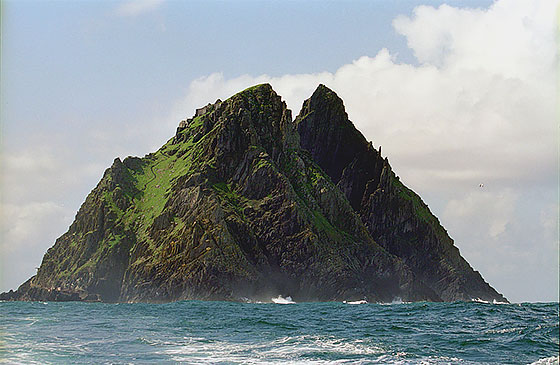
Skellig Michael (Irish: Sceilig Mhichíl), is the larger of the two Skellig Islands, in County Kerry. Most of the island, including the remains of the 7th century Gaelic Christian monastery became a UNESCO World Heritage Site in 1996. Photo by Jerzy Strzelecki (own work) [CC BY-SA 3.0 or GFDL], via Wikimedia Commons.
DAY 10
Tuesday, July 24: The Barren Burren
The dramatic Carboniferous Cliffs of Moher and the brilliantly white karst landscape of the Burren National Park are today’s destinations. Recipients of both UNESCO Geopark status and a 100 Great Geosites ranking, these two stunning sites exemplify the interaction of bedrock and glacial and coastal erosional processes responsible for Ireland’s diverse and majestic terrain.
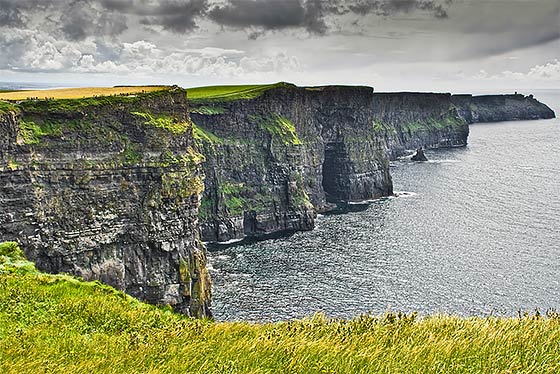
The Cliffs of Moher located at the southwestern edge of the Burren region in County Clare, Ireland. They rise 390 ft above the Atlantic Ocean at Hag’s Head, and, eight kilometres to the north, reach their maximum height of 702 ft just north of O’Brien’s Tower.
DAY 11
Wednesday, July 25: Search for your Galway shawl
After a behind the scenes tour of the 19th century James Mitchell Geology Museum, you’re free to explore the brightly painted, bohemian city of Galway. Hailed by the New York Times as Ireland’s “most Irish city”, relax in the pubs, soak up the city’s vibrant arts culture, or shop for handcrafted goods as you take a much needed break.
DAY 12
Thursday, July 26: Marble & Fjords
We travel through the “savage beauty” of the Connemara region to visit Connemara National Park, stopping at the Connemara Marble Visitor’s Centre to see the diversity of marbles produced by the tectonic cooking of Cryogenian limestones, and Killary Harbour, Ireland’s only fjord.
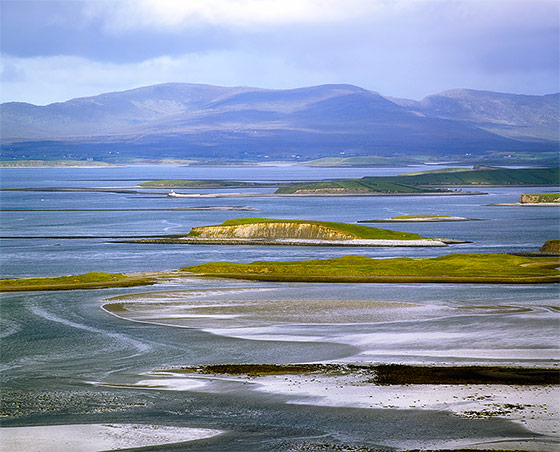
Clew Bay contains Ireland’s best example of sunken drumlins. Drumlin is from the Irish word droimnín “littlest ridge”—an elongated hill formed by the movement of glacial ice.
DAY 13
Friday, July 27: The Western Coast
A loop takes us through County Mayo. The first stop is Clew Bay, whose hundreds of tiny islands are actually a field of submerged drumlins, enigmatic structures left behind by retreating glaciers.
Then it’s on to Ballycroy National Park for a walking tour of the pristine blanket bog habitat preserved in the region.
At the next stop, Annagh Head, you’ll interact with the oldest rocks in Ireland: at 1.75 Ga years old they predate the oldest fossils of cells with nuclei.
We’ll end the day at Céide Fields, the world’s best example of a Neolithic farmed landscape, capturing the transition from hunter gather to agricultural society.
DAY 14
Saturday, July 28: The Land of Yeats
The day is spent exploring the ancestral home of William Butler Yeats, Ireland’s most famous poet. A romantic countryside of lakes, rivers, forest, overseen by limestone ridges and the iconic table mountain of Benbulbin.
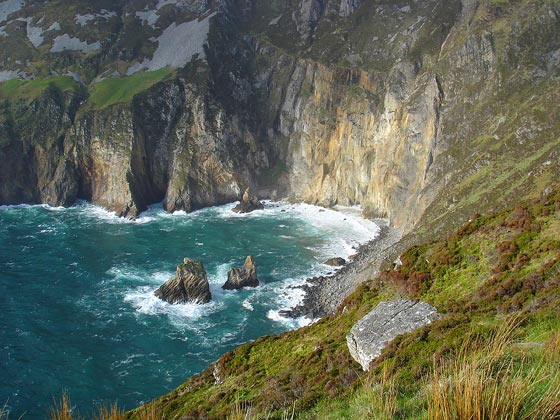
Slieve League (Irish: Sliabh Liag), is a mountain on the Atlantic coast of County Donegal, Ireland. At 1,972 ft, it has some of the highest sea cliffs on the island. Although less famous than the Cliffs of Moher, Slieve League’s cliffs reach almost three times higher. Photo by Brholden (own work) [Public domain], via Wikimedia Commons.
DAY 15
Sunday, July 29: The Edge of the World
The cliffs at Slieve League, some of the highest in the world, tower a staggering 2,000 feet above the Atlantic Ocean. You’ll experience them from above and below. Starting at the Slieve League viewing platform for a safe, but exhilarating view from the top. After that, we’ll descend to the harbour below for a personal boat tour of the base of cliffs, keeping an eye out for basking sharks and dolphins.
After the wild morning, we’ll calm down in Glenveagh National Park: 40,000 acres of unspoiled wilderness that surround the lush gardens and buildings of Glenveagh Castle.
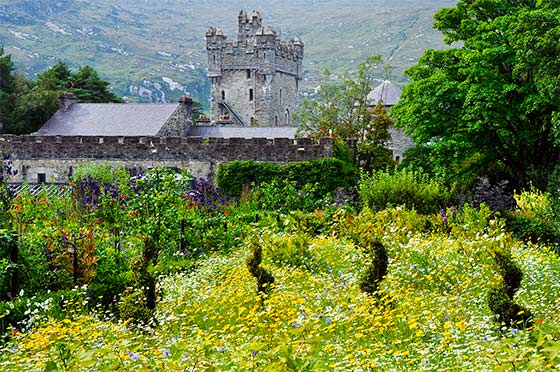
Glenveagh Castle (Irish: Caisleán Ghleann Bheatha) is a large castellated Mansion house built in County Donegal, Ireland, built between 1870 and 1873 by Captain John George Adair. It stands within the boundaries of Glenveagh National Park.
DAY 16
Monday, July 30: Giants & Thrones
The day begins at Potrush Nature Reserve, ground zero for an epic intellectual battle in the early history of geology, where fossils appear to be preserved in volcanic rocks.
Then we move onto the Giant’s Causeway, perhaps the most iconic geological site in the world, where 40,000 columns of basalt create an unearthly sight that begs for a supernatural explanation.
And we’ll finish up the day Ballintoy Harbour, a starkly beautiful landscape of basalt and chalk that you might recognize as the setting of the Iron Islands on Games of Thrones.
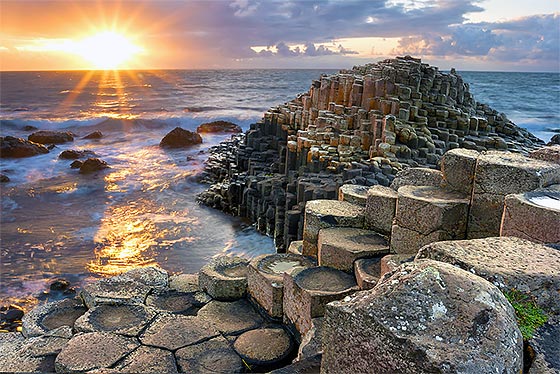
The Giant’s Causeway, County Antrim, Northern Ireland, is an area of about 40,000 interlocking basalt columns, the result of an ancient volcanic eruption. It was declared a UNESCO World Heritage Site in 1986.
DAY 17
Tuesday, July 31: Maritime Mega Disasters
We head to Belfast to take in the international award-winning Titanic Belfast, where the history and tragedy of the ill-fated voyage are brought to life in nine massive, interactive galleries. We then head to Harland & Wolff for a behind the scenes tour.
Before heading to the city, however, we’ll stop at the site of a far larger maritime disaster. At Waterloo Bay, deposits formed by ancient mega tsunamis herald the coming of the one of the greatest mass extinctions in Earth history.
If time allows, the day will wrap up with a group tour of the Ulster Museum, home to Northern Ireland’s preeminent collection of fossils, rocks, and minerals.
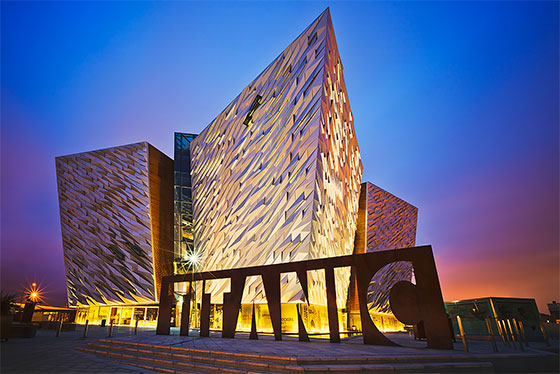
The Titanic Experience—explore the shipyard, walk the decks, travel to the depths of the ocean and uncover the true legend of Titanic in the city of Belfast where it all began.
DAY 18
Wednesday, August 1: Coming Full Circle
The final leg of our tour takes us back to Dublin, but not before we stop at another famous circle: the Ring of Guillion. Officially designated an Area of Outstanding Natural Beauty, the ring is a massive circle of volcanic rock formed by the collapse of volcano 58 million year ago.
Enroute to the Ring of Guillion, we’ll visit the Mourne Mountains, North Ireland’s highest peaks, towering blocks of granite emplaced at during the same volcanic events that produced the Ring and the Giant’s Causeway.
Farewell dinner
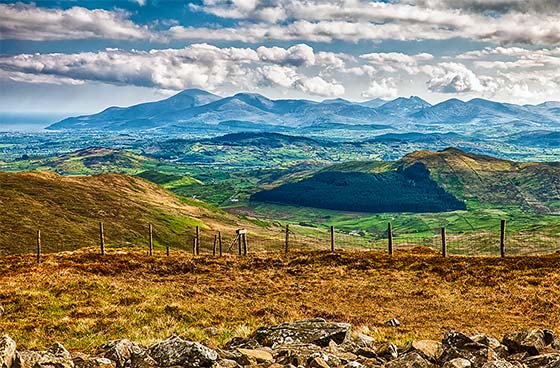
View from Slieve Croob of the Mourne Mountains, a granite mountain range in County Down, that includes the highest mountains in Northern Ireland, the highest of which is Slieve Donard at 2,790 ft.
DAY 19
Thursday, August 2: Homewards
All details above are subject to change.
OUR TOUR LEADER
Dr. Jason Loxton

We are pleased to announce that award-winning science educator and Geologist/palaeontologist Dr. Jason Loxton will be leading our Irish tour. A longtime skeptic and passionate science communicator, he is renowned for his talent and wit as a lecturer, and his public science outreach in schools, museums, and science competitions. Jason’s teaching style has been described as “clear,” “hilarious,” and “crazy excited.” He holds a 4.9 rating (out of 5) on ratemyprofessors.com.
Dr. Loxton has developed science curricula for the Ontario Ministry of Natural Resources and conducted climate change education research for Nova Scotia’s environment department. He sits on the scientific advisory board for the Joggins Fossils Institute, at the Joggins Fossil Cliffs UNESCO World Heritage Site, and was the co-organizer of the 2016 Canadian Paleontological Conference.
He received his Ph.D. from Dalhousie University and is a senior geology instructor at Cape Breton University, in Nova Scotia, Canada. His academic publications focus on paleontology, climate change education, and science communication. Loxton’s PhD research (part of which was recently published in the Proceedings of the National Academy of Science) focused on the Late Ordovician Mass Extinction, and involved hands-on research in the northern Yukon, Scotland, and China. He has also conducted field work with the Geological Survey of Canada and Royal Ontario Museum, the latter at the famous “Cambrian Explosion” Burgess Shale locality.
He studies the taxonomy and distribution of Ordovician/Silurian graptolites—or “really boring-looking smudges,” he says cheerfully. This eye-straining endeavor may be “unglamorous and decidedly not trendy,” as he describes it, but it is just the type of ongoing fossil detective work which has allowed generations of geologists to painstakingly piece together the history of our planet. These kinds of fossil to rock layer comparisons are known as biostratigraphy, which means using fossils to divide the rock record into relative units of time. And for that, modest fossils like Jason’s smudges are just the thing.
He is the brother of Skeptic magazine author and illustrator Daniel Loxton.
Questions & Registration
Please contact The Skeptics Society office at geotours@skeptic.com or call 1-626-794-3119 with questions or with a credit card to secure your spot.
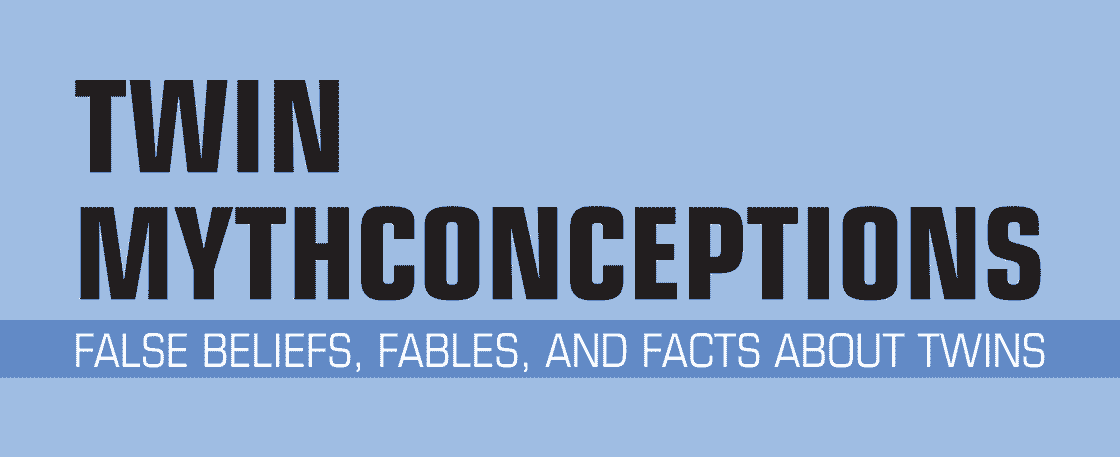
OUR NEXT SCIENCE SALON: SEPTEMBER 17
Dr. Nancy Segal — Twin Mythconceptions: False Beliefs, Fables, and Facts about Twins

Dr. Nancy Segal, the world’s leading expert on twins, has a new book that sheds light on over 70 commonly held ideas and beliefs about the origins and development of identical and fraternal twins. Using the latest scientific findings from psychology, psychiatry, biology, and education, Dr. Segal separates fact from fiction. Each idea about twins is described, followed by both a short answer about the truth, and then a longer, more detailed explanation…
Reserve your seat(s) online or by calling 1-626-794-3119. Online reservation closes Sunday September 17, 2017 at 11am PDT.
IN CELEBRATION OF 25 YEARS OF SKEPTIC
Get 25% off the film: Reasons To Believe
It is no secret we live in some challenging times. In the world of fake news, alternative facts, and irrational belief systems, it is often difficult to know how we find the truth.
For the past 25 years Skeptic magazine has been at the forefront of helping people use skepticism to become better critical thinkers and question irrational belief systems. In keeping with the skeptic movement, the new documentary Reasons to Believe featuring Michael Shermer, asks the questions of why do we believe and why is it so hard for us to change our minds? How can we use science and reason to combat ideology?
In celebration of the release of the documentary on September 11th, 2017 and the 25th anniversary of Skeptic magazine, we want to say thank you to all current and new subscribers of Skeptic magazine by giving a limited time offer of 25% off the rental or purchase of the documentary on Vimeo.
Enter promo code skeptic25 to get the discount. Stream the film online at: http://vimeo.reasonstobelievefilm.com/. The promo code is limited to the first 2000 people and it expires: 09/25/2017
We hope to continue to give you the best content possible and appreciate you supporting us with a tax-deductible donation to The Skeptics Society.


